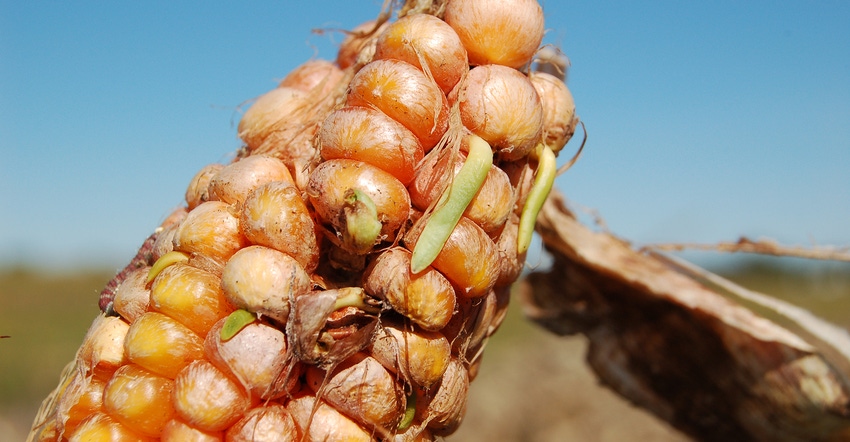October 1, 2019

We had a very late start in most areas of the Corn Belt this year. Hot and dry weather during summer was not conducive to most leaf disease organisms, though gray leaf spot established itself in some areas. Northern corn leaf blight set up shop in other areas, and southern rust and tar spot came in later in some fields.
Depending on your microclimate, you might see certain ear and kernel rots this year. The amount of rain received during the grain fill period is related to the prevalence of rots. Because we don’t know which pathogens might rear their ugly heads, we’ll discuss the most important ear rots.
Diplodia. This ear rot is caused by a fungus, Diplodia maydis, which also causes stalk rot. Infections occur within two weeks after silking. Shanks and husks of infected ears look bleached or straw-colored. Infections usually start at the base of ears and spread to kernels. Eventually, the whole ear may rot. When husks are peeled back, you can see white mold between kernel rows.
Fusarium. The fungus Fusarium moniliforme causes this rot, and it attacks corn ears and kernels. Fusarium produces pink-to-red discoloration, usually starting at the tip of ears. Infected kernels become covered with pink mold, which contains millions of microscopic spores. This fungus may also cause stalk rot.
Gibberella. The culprit of this rot is the fungus Gibberella zeae. It starts at the tip of the ear and also causes stalk rot. Kernels become reddish as the disease spreads to the entire ear. This ear rot is toxic to pigs and dogs, causing vomiting, weight loss and even death. Pigs refuse to eat infected ear corn if more than 5% to 10% of the ears are rotten.
Aspergillus. Aspergillus flavus, another fungus, causes this rot. Hot, dry seasons and corn with nitrogen deficiency may increase susceptibility. This pathogen infects ears damaged by corn earworm, corn borer and other insects. It’s usually found on ear tips. High temperatures favor the spread of this disease. It produces bluish-green to green mold on kernels. The fungus produces carcinogenic aflatoxin, which can cause serious feeding problems in animals and human food. Stored corn infected with this fungus may be rejected by elevators based on strict limits set by the Food and Drug Administration and USDA.
Corn smut. Ustilago zeae is the fungus that causes corn smut. It produces big galls of plant tissue full of black spores. It can attack throughout the growing season on any part of the plant. Spores usually enter plants through injuries caused by insects or mechanical damage. If it occurs on the lower parts of the plants, it can cause barrenness. Dry weather or abnormally cool, wet weather favors smut.
There are other ear rots — such as cladosporium, trichoderma, pennicillium and nigrospora — but they are usually not of economic importance. Most of these fungi overwinter in stored grain, soil or crop residue. Continuous corn tends to increase incidence of these diseases. Crop rotations and cover crops keep soils healthy and reduce the amount of these pathogens.
Nanda is director of genetics for Seed Genetics-Direct, Jeffersonville, Ohio. Email him at [email protected] or call him at 317-910-9876.
About the Author(s)
You May Also Like






